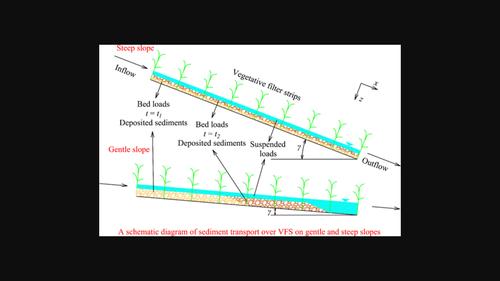当前位置:
X-MOL 学术
›
Hydrol. Process.
›
论文详情
Our official English website, www.x-mol.net, welcomes your
feedback! (Note: you will need to create a separate account there.)
Modelling sediment trapping in vegetative filter strips on steep slopes
Hydrological Processes ( IF 2.8 ) Pub Date : 2022-12-26 , DOI: 10.1002/hyp.14793
Songbai Wu 1, 2 , Ting Fong May Chui 1 , Li Chen 3 , Chun Hon Christopher Chow 1
Hydrological Processes ( IF 2.8 ) Pub Date : 2022-12-26 , DOI: 10.1002/hyp.14793
Songbai Wu 1, 2 , Ting Fong May Chui 1 , Li Chen 3 , Chun Hon Christopher Chow 1
Affiliation

|
The slope effects on sediment trapping process in vegetative filter strips (VFS) are usually neglected in current modelling practices for VFS operation, which hamper the VFS design and performance evaluation, especially on steep slopes. To fill the knowledge gap, 12 laboratory experiments of sediment trapping in VFS were conducted with three different inflow discharge (80, 100, and 120 ml s−1) and four slope angles (5,10, 15, and 20°). The experimental results show that, on steep slopes (10, 15, and 20°), a part of trapped sediment particles in VFS can be eroded again and then dragged to the downstream as bed load, whilst they do not move on gentle slope (5°). To describe the complex processes, a simple and effective modelling framework was developed for sloped VFS by coupling the slope infiltration, runoff, and modified sediment transport model. The model was tested against the experimental results and good agreements between the modelled and observed results were found in both runoff and sediment transport processes for all cases. On steep slopes, the sediment trapping performance of VFS decreases significantly because the erosion of deposited sediment particles can account for more than 60% of the sediment load in the outflow. The slope effect on sediment trapping efficiency of VFS varies greatly with soil, VFS, and slope properties. The model was compared with previous sediment transport equation and found that both methods can satisfactorily predict the sediment trapping of VFS on gentle slopes, but previous sediment transport equation is likely to overestimate the sediment trapping efficiency in VFS on steep slopes. This model is expected to provide a more realistic and accurate method for predicting runoff and sediment reduction in VFS on sloping surfaces.
中文翻译:

模拟陡坡植被过滤带中的沉积物捕获
在当前的 VFS 操作建模实践中,坡度对植物滤水带 (VFS) 沉积物捕获过程的影响通常被忽略,这阻碍了 VFS 设计和性能评估,尤其是在陡坡上。为了填补知识空白,在 VFS 中进行了 12 项沉积物捕集实验室实验,采用三种不同的流入流量(80、100 和 120 ml s -1) 和四个倾斜角(5、10、15 和 20°)。实验结果表明,在陡坡(10°、15°和20°)上,VFS中截留的部分泥沙颗粒可以再次被侵蚀,然后作为床荷被拖到下游,而在缓坡上则不会移动( 5°)。为了描述复杂的过程,通过耦合斜坡渗透、径流和修改后的泥沙输运模型,为斜坡 VFS 开发了一个简单有效的建模框架。该模型根据实验结果进行了测试,并且在所有情况下的径流和沉积物输送过程中都发现了模拟结果与观测结果之间的良好一致性。在陡坡上,VFS 的泥沙截留性能显着下降,因为沉积泥沙颗粒的侵蚀可占出流泥沙负荷的 60% 以上。坡度对 VFS 沉积物捕获效率的影响随土壤、VFS 和坡度特性的不同而有很大差异。将模型与以往输沙方程进行对比发现,两种方法均能较好地预测VFS在缓坡上的泥沙截留,但以往输沙方程可能高估了VFS在陡坡上的截沙效率。该模型有望为预测坡面上 VFS 的径流和泥沙减少提供更真实和准确的方法。但以前的泥沙输运方程可能会高估 VFS 在陡坡上的泥沙捕集效率。该模型有望为预测坡面上 VFS 的径流和泥沙减少提供更真实和准确的方法。但以前的泥沙输运方程可能会高估 VFS 在陡坡上的泥沙捕集效率。该模型有望为预测坡面上 VFS 的径流和泥沙减少提供更真实和准确的方法。
更新日期:2022-12-26
中文翻译:

模拟陡坡植被过滤带中的沉积物捕获
在当前的 VFS 操作建模实践中,坡度对植物滤水带 (VFS) 沉积物捕获过程的影响通常被忽略,这阻碍了 VFS 设计和性能评估,尤其是在陡坡上。为了填补知识空白,在 VFS 中进行了 12 项沉积物捕集实验室实验,采用三种不同的流入流量(80、100 和 120 ml s -1) 和四个倾斜角(5、10、15 和 20°)。实验结果表明,在陡坡(10°、15°和20°)上,VFS中截留的部分泥沙颗粒可以再次被侵蚀,然后作为床荷被拖到下游,而在缓坡上则不会移动( 5°)。为了描述复杂的过程,通过耦合斜坡渗透、径流和修改后的泥沙输运模型,为斜坡 VFS 开发了一个简单有效的建模框架。该模型根据实验结果进行了测试,并且在所有情况下的径流和沉积物输送过程中都发现了模拟结果与观测结果之间的良好一致性。在陡坡上,VFS 的泥沙截留性能显着下降,因为沉积泥沙颗粒的侵蚀可占出流泥沙负荷的 60% 以上。坡度对 VFS 沉积物捕获效率的影响随土壤、VFS 和坡度特性的不同而有很大差异。将模型与以往输沙方程进行对比发现,两种方法均能较好地预测VFS在缓坡上的泥沙截留,但以往输沙方程可能高估了VFS在陡坡上的截沙效率。该模型有望为预测坡面上 VFS 的径流和泥沙减少提供更真实和准确的方法。但以前的泥沙输运方程可能会高估 VFS 在陡坡上的泥沙捕集效率。该模型有望为预测坡面上 VFS 的径流和泥沙减少提供更真实和准确的方法。但以前的泥沙输运方程可能会高估 VFS 在陡坡上的泥沙捕集效率。该模型有望为预测坡面上 VFS 的径流和泥沙减少提供更真实和准确的方法。







































 京公网安备 11010802027423号
京公网安备 11010802027423号